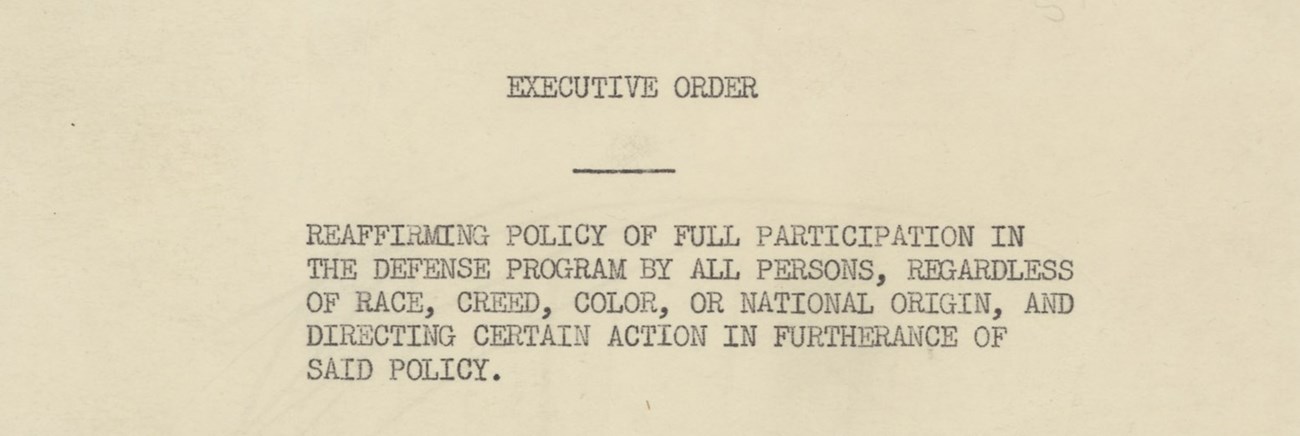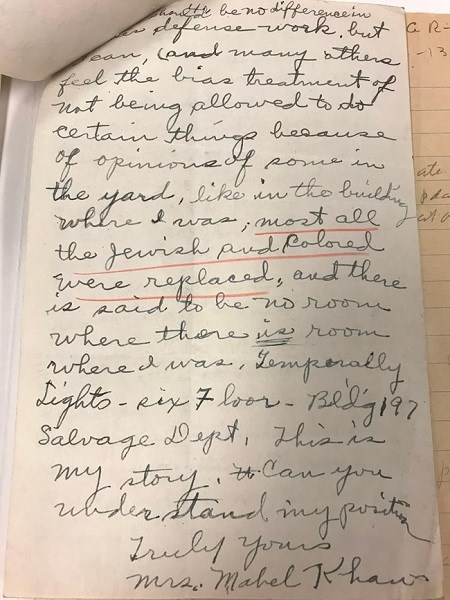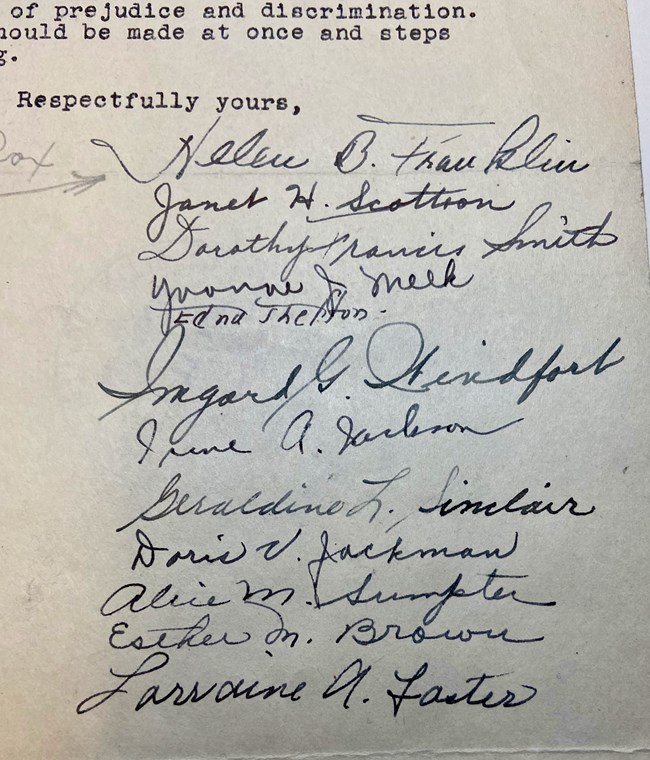Last updated: February 20, 2025
Article
Discrimination and African American Women at Charlestown Navy Yard
African American women involved in the suffrage movement and subsequent social movements confronted both gender and race discrimination as they pushed for equality in political, social, and economic realms. Although women in general began making strides in the workplace during World War II, African American women faced various barriers due to their race and gender.
Black women sometimes struggled to get hired, obtain promotions, and garner respect in the workplace. Believing that "victory abroad [should] be accompanied by a war against racism at home," many African American women used the resources available to them to fight back against these injustices.[1] At the Charlestown Navy Yard, two of these women were Mabel Kahn and Helen Lee Franklin. These women’s actions highlight the continued fight for women’s rights after the passage of the 19th Amendment.
The Charlestown Navy Yard employed African American women for a variety of jobs: from clerks and electrician helpers, to mechanics and welders. Some faced prejudice at the Navy Yard, while others did not. Every African American’s experience differed depending on which shop they worked in, who they interacted with, or who were their supervisors.
To help Black workers overcome employment barriers on the home front, President Franklin Delano Roosevelt signed Executive Order 8802 in 1941, banning discrimination in the defense industry.

National Archives
At this time, he also established the Fair Employment Practices Committee (FEPC), which investigated discrimination in hiring practices and in the workplace. Many African Americans, especially women, saw this committee as a tool to fight prejudice they faced at work.
Between July 1943 and December 1944, Black women across the country filed at least one out of every four race discrimination cases to the FEPC.[2] When Mabel Kahn and Helen Lee Franklin believed they experienced prejudice, they used this avenue, and others, to bring attention to race discrimination at the Charlestown Navy Yard.

Mabel Kahn to Frances Perkins, Secretary of Labor, November 4, 1944; Charlestown Navy Yard, 1-GR-130, 1944-1945; Closed Regional Case Records, 1943-1946, Box 2; Records of the Committee on FEP 1940-1946, Record Group 228; National Archives at Boston.
Mabel Kahn
From 1943 until the summer of 1944, Mabel Kahn worked as a relief matron at the electric shop in the Charlestown Navy Yard before temporarily resigning due to illness. When she attempted to return to work in September 1944, Kahn believed race discrimination prevented her from doing so.
Although Kahn passed the required physical examination needed to resume working, the Labor Board assigned her to the rope walk since no positions were open at the electric shop.[3] Once she arrived for duty, the foreman told her "he could not use a person of [her] size" for the job, and sent her back to the labor board to wait for another job.[4]
Still waiting for a job and concerned about providing for her seven children, Mabel Kahn grew impatient. She began to question why the Navy Yard would not give her a job when she had passed her physical examination and knew jobs were available. Kahn contacted city officials, including Boston Mayor Maurice Tobin, for help. While she made little progress with the mayor's office, she subsequently received a letter from the Navy Yard telling her she "had not passed her physical exam and could not be hired."[5] This chain of events led her to conclude she was being discriminated against due to her race.
In November, Mabel Kahn called upon the FEPC and the US Secretary of Labor, Frances Perkins, to investigate her case. In her explanation, she highlighted evidence of discrimination at the Navy Yard. Kahn believed a supervisor had personally targeted her and blocked her from reapplying for her previous position, and the Navy Yard purposefully replaced her with an Irish woman.[6]
She wrote Secretary Perkins, "I can, and many others feel the bias treatment of not being allowed to do certain things because of opinions of some in the yard, like in the building where I was; most all the Jewish and colored were replaced, and there is said to be no room where there is room where I was."[7] Even after her attempts to receive justice, the FEPC dismissed Mabel Khan's case on merits due to her health and her explicit desire to return to her previous position, which was not currently open.[8]

Helen Franklin et al. to Richard Walker, Fair Employment Practice Committee, November 6, 1943; Boston Navy Yard, 1-GR-55, 1943-44; Closed Regional Case Records, 1943-46, Box 1; Records of the Committee on FEP 1940-46, Record Group 228, National Archives.
Helen Lee Franklin
While Mabel Kahn turned to city and federal officials for help in addition to the FEPC, Helen Lee Franklin followed a different path. Franklin joined forces with 11 other women and submitted a letter to the FEPC notifying it of discrimination in their typist training section at the Charlestown Navy Yard.[9]
Their November 6, 1943 letter stated their complaints. First, they believed their section was being "segregated as a 'colored group'" and that "all through the building and offices began whisperings that this was going to be made into a 'Jim Crow' section."[10] When approached with this concern, their supervisors did not take action. Second, they watched equally or lesser trained White women get promoted, while supervisors "refused or ignored" their requests.[11]
Not willing to wait for a response from the FEPC, Helen Franklin contacted the President of the Boston Branch of the NAACP, Julian Steele, about her case. She, like many other African Americans at the time, viewed the NAACP as another avenue to push for civil rights. In response, Steele wrote, "I am looking into the matter of Jim Crow at the Navy Yard. There have been other complaints besides yours, and I feel that something vigorous should be done to halt this practice."[12] He informed her that he would meet with her group and also contact the President of the Boston Urban League, another organization that supported African American employment rights, to assist in their case.
Over the next few months, Franklin and her colleagues waited for the FEPC and Charlestown Navy Yard to respond to their claim. The Navy Yard's reluctance to cooperate resulted in a drawn out investigation. Though some investigators internally admitted discrimination occurred at the Navy Yard, they conceded that they could not prove it sufficiently. The FEPC eventually dismissed Helen Franklin and her colleagues' case based on merits since there was not enough evidence to prove the discrimination.[13]
Nationally, the FEPC successfully resolved only one third of the cases brought to its attention.[14] At the Charlestown Navy Yard, the FEPC dismissed seven out of the eight race discrimination cases, with one case remaining active.
Despite the negative results of their cases, Mabel Kahn and Helen Lee Franklin's persistence called attention to the institutional discrimination faced by Black women at the Navy Yard. By using the tools at their disposal, these two women left a record of their attempts to combat discrimination in the defense industry, shedding light on the often overlooked social battles happening on the home front. Their tenacity embodied the same resolve as their predecessors in the suffrage movement. By joining the workforce and fighting for their rights, these women took the first steps towards equality in the workplace.
Contributed by: Megan Woods, SCA Public Historian
Footnotes
[1] Susan M. Hartmann, The Home Front and Beyond: American Women in the 1940s, 5.
[2] Hartmann, The Home Front and Beyond, 81-82.
[3] Mabel Kahn to Madison Jones of the Fair Employment Practices Committee, January 12, 1945; Charlestown Navy Yard, 1-GR-130, 1944-1945; Closed Regional Case Records, 1943-1946, Box 2; Records of the Committee on Fair Employment Practice 1940-1946, Record Group 228; National Archives at Boston.
[4] Mabel Kahn to Madison Jones of the Fair Employment Practices Committee, January 12, 1945; Charlestown Navy Yard; National Archives at Boston.
[5] Mabel Kahn to Madison Jones of the Fair Employment Practices Committee, January 12, 1945; Charlestown Navy Yard; National Archives at Boston.
[6] Mabel Kahn to Frances Perkins, Secretary of Labor, November 4, 1944 and Mabel Kahn to Madison Jones of the Fair Employment Practices Committee, January 12, 1945; Charlestown Navy Yard, 1-GR-130, 1944-1945; Closed Regional Case Records, 1943-1946, Box 2; Records of the Committee on Fair Employment Practice 1940-1946, Record Group 228; National Archives at Boston.
[7] Mabel Kahn to Frances Perkins, Secretary of Labor, November 4, 1944; Charlestown Navy Yard; National Archives at Boston.
[8] Final Disposition Report, January 17, 1945; Charlestown Navy Yard, 1-GR-130, 1944-1945; Closed Regional Case Records, 1943-1946, Box 2; Records of the Committee on Fair Employment Practice 1940-1946, Record Group 228; National Archives at Boston.
[9] Helen Franklin’s colleagues are as follows: Janet H. Scottron, Dorothy Francis Smith, Yvonne J. Meek, Edna Thefton, ImgardWindfort, Irena A. Jackson, Geraldine L. Sinclair, Doris V. Jackman, Alice M. Sumpter, Esther M. Brown, Larraine A. Foster.
[10] Helen Franklin et al. to Richard Walker, Fair Employment Practice Committee, November 6, 1943; Boston Navy Yard, 1-GR-55, 1943-1944; Closed Regional Case Records, 1943-1946, Box 1; Records of the Committee on Fair Employment Practice 1940-1946, Record Group 228; National Archives at Boston.
[11] Helen Franklin et al. to Richard Walker, Fair Employment Practice Committee, November 6, 1943; Boston Navy Yard; National Archives at Boston.
[12] Julian D. Steele to Helen Franklin, November 19, 1943, Julian D. Steele Collection, NAACP Correspondence 1936-1944, Box 20, Folder 6, Howard Gotlieb Archival Research Center at Boston University, Boston, Massachusetts.
[13] Final Disposition Report, April 12, 1944; Boston Navy Yard, 1-GR-55, 1943-1944; Closed Regional Case Records, 1943-1946, Box 1; Records of the Committee on Fair Employment Practice 1940-1946, Record Group 228; National Archives at Boston.
[14] Hartmann, The Home Front and Beyond, 5.
Bibliography
Anderson, Karen Tucker. “Last Hired, First Fired: Black Women Workers during World War II.” The Journal of American History 69, no. 1 (June 1982). 82-97.
Boris, Eileen. “‘You Wouldn’t Want One of ‘Em Dancing with Your Wife’: Racialized Bodies on the Job in World War II.” American Quarterly 50, no. 1 (Mar., 1998). 77-108.
Boston Navy Yard, 1-GR-55, 1943-1944; Closed Regional Case Records, 1943-1946, Box 1; Records of the Committee on Fair Employment Practice 1940-1946, Record Group 228; National Archives at Boston. Boston Navy Yard, Boston, MA; Case # 1-GR-55.
Charlestown Navy Yard, 1-GR-130, 1944-1945; Closed Regional Case Records, 1943-1946, Box 2; Records of the Committee on Fair Employment Practice 1940-1946, Record Group 228; National Archives at Boston. Charlestown Navy Yard, Boston, MA: Case # 1-GR-130.
Hartmann, Susan M. The Home Front and Beyond: American Women in the 1940s. Boston: Twayne Publishers, 1982.
Hirshfield, Deborah. “Gender, Generation, and Race in American Shipyards in the Second World War.” The International History Review 19, no. 1 (February 1997).
Steele, Julian D.. “Julian D. Steele to Helen Franklin, November 19, 1943.” Julian D. Steele Collection, NAACP Correspondence 1936-1944, Box 20, Folder 6. Howard Gotlieb Archival Research Center at Boston University. Boston, Massachusetts.
Tuft, Paige. “They are Hiring the White Women but They Won’t Hire the Colored Women”: Black Women Confront Racism and Sexism in the Richmond Shipyards During World War II.” Masters thesis, Utah State University, 2015 http://digitalcommons.usu.edu/etd/4285.
Tags
- boston national historical park
- african american women
- african american history
- world war ii
- activism
- navy yard
- charlestown navy yard
- boston navy yard
- discrimination
- civil rights
- beyond suffrage
- black womanhood series
- boston
- women's history
- labor history
- massachusetts
- industrial history
- homefront
- military history
- women
- world war ii home front
